2018 Nissan Rogue Sport Vs Honda HR-V Comparison

The subcompact crossover segment is an important one and Honda has a bestseller with the HR-V. The Nissan Rogue Sport (aka the Qashqai in Canada)is new this year and wants to steal some of Honda’s thunder, so we’ve compared them head to head to see which one is better. Here’s what we thought.
Get the Flash Player to see this player.
The Honda HR-V used to have a lot going for it, but it’s quickly falling behind in the segment. That doesn’t mean it’s not good, because it is very good, but it’s no longer the best.
The HR-V is powered by a 1.8L four-cylinder engine with 141 hp and 127 lb-ft of torque, which gets to the front or all four wheels via a CVT. Continuously variable gearboxes like this are the reason why these transmissions have such a bad reputation — it is annoyingly loud and unresponsive. Any calls for quick acceleration are met with groans and protests from the HR-V, so getting anywhere takes a lot of patience. Despite this, the Honda still has good driving dynamics, meaning steering feels good (though still quite vague) and the suspension is good at ironing out rough roads better than the Rogue Sport. On a positive note, the improved 2019 Honda HR-V will get more sound deadening, so hopefully, it will help drown out the CVT whine.
The interior is pretty drab and while it looks OK, the functionality suffers because there are no hard buttons, meaning you have to take your eyes off the road to do anything. Important functions in the infotainment system are also hidden in the touchscreen’s menu, which makes it grating to use every day.
2019 Honda HR-V models get Apple CarPlay and Android Auto, which is great because the stock infotainment system is pretty bad — it looks dated and is slow, and the graphics and user-friendliness isn’t great since there’s still no volume knob. New 2019 models also get Honda Sensing, which gives it driver assistance and safety features but still not enough to match the Rogue Sport in terms of tech. It has lane-keep assist and collision mitigation, but it’s too aggressive and annoying, meaning it’s easier to just turn it off.
A unique feature is the Lane Watch camera, which gives you a video feed of your right blind spot when you signal to change lanes to the right. In theory, it seems like a good idea, but it ends up being too gimmicky and not that useful because it’s information you can get just by doing a shoulder check. Visibility out of the back is also great and you end up having to decipher information from the video feed, which takes too long when you need to make a snap decision. The only instance I found it half useful was double-checking for cyclists while driving through the city.
In contrast, the Magic Seats, which fold upward to allow you to fit taller objects behind the front row, are still a star feature. This is a truly useful and practical feature that I wish more cars had. Cargo capacity is rated at 23.2 cubic feet in the trunk and 55.9 with the seats down.
ALSO SEE: 2018 Hyundai Kona Review
Like I mentioned in the beginning, the HR-V is good, but I can’t help but expect more from Honda. The Japanese brand has been pumping out some amazing products and the HR-V feels like it could use some love from the company to make it a segment leader again.
Compare Specs
| Vehicle | Honda HR-V | Advantage | Nissan Rogue Sport/Qashqai |
|---|---|---|---|
| Engine | 1.8L 4-cyl | - | 2.0L 4-cyl |
| Horsepower | 141 | - | 141 |
| Torque | 127 lb-ft | Nissan | 147 lb-ft |
| Transmission | CVT | - | CVT |
| Cargo Capacity cu-ft | 23.2/55.9 | Nissan | 22.9/61.1 |
| Combined MPG | 29 | Honda | 27 |
| Combined L/100 km | 8.2 | Honda | 8.4 |
| US Starting Price | $20,520 | Honda | $22,110 |
| CAN Starting Price | $23,100 | Nissan | $19,998 |
Nissan Rogue Sport/Qashqai
The Rouge Sport (which is also called the Qashqai in Canada and other parts of the world), is new to North America this year. It will be followed by the new Nissan Kicks, an even more compact and truer competitor to the HR-V. The Rogue Sport also looks like a small Rogue, meaning it’s pretty handsome for a CUV and definitely better looking than the HR-V, espescially in this Canada only shade of green called Nitro Lime Metallic.
As soon as the Rogue Sport came into town, it took away the one thing the HR-V did better than all its competitors – cargo capacity. It boasts 22.9 cubic feet in the trunk and 61.1 with the seats down, which handily beats the Honda’s overall figure of 55.9 cu-ft.
The Rogue is powered by a 2.0L four-cylinder with 141 hp and 147 lb-ft of torque and gets power to the front or all four wheels via a CVT (Canadians also get a manual option). Horsepower is equal to the HR-V, but the extra torque shines through and makes the Nissan feel a bit less lethargic than the Honda. Driving dynamics are, in a word, soft. The steering is light enough to be done with one finger, the suspension is squishy, making the Rogue Sport lean a lot in the corners, and the brakes are mushy and unresponsive. It definitely does not drive as well as the Honda, though its CVT is much less annoying than the HR-V’s.
Where it excels is with tech: the Nissan is available with forward emergency braking with pedestrian detection, lane departure warning and prevention, blind spot monitoring, rear cross traffic alert, the excellent top-down around-view monitor with moving object detection, adaptive cruise control, remote engine start, hill start assist, and more. Like most other systems, the lane departure warning is too sensitive and annoying, so I just turn it off. The adaptive cruise control, however, operates in a smooth and intuitive way. The Honda isn’t available with most of these features.
ALSO SEE: 2018 Toyota C-HR vs 2018 Kia Soul
The Rogue is lacking in a few areas — no Apple CarPlay or Android Auto, only one USB port, and the interior is kind of drab. The seating position is also a bit awkward and the infotainment system is OK but looks dated and can be laggy at times. It’s much more user-friendly than Honda’s system, however, mainly because it has hard buttons that simplify certain tasks.
The Verdict: 2018 Nissan Rogue Sport vs Honda HR-V Comparison
These two CUVs are pretty equally matched and it was difficult to pick a winner.
Although the Honda has more buttoned-down driving dynamics, it doesn’t go above and beyond in any other aspect. There’s nothing the HR-V does better than anything else in its segment and it’s quickly falling behind, even though it was just refreshed for 2019. There isn’t a single compelling reason to buy it, though that doesn’t mean it’s a bad car. It’s very good at doing what it was intended to.
The Rogue Sport is easier to live with day to day, has more cargo capacity, more tech, and is less frustrating in general. What impressed us about the Rogue Sport is that it didn’t feel like a cheaper version of its big sibling. Even though you’d be getting the budget option, Nissan isn’t punishing you for it and you get the same quality as a more expensive car. The HR-V, on the other hand, feels obviously cheaper and you can tell that Honda made some sacrifices to get to its price point. For these reasons, the Rogue is the one we’d pick out of the two.

Jodi has been obsessed with cars since she was little and has been an automotive journalist for the past 12 years. She has a Bachelor of Journalism from Ryerson University in Toronto, is a member of the Automobile Journalists Association of Canada (AJAC), and a jury member for the prestigious North American Car/Truck/Utility Vehicle of the Year (NACTOY). Besides hosting videos, and writing news, reviews and features, Jodi is the Editor-in-Chief of AutoGuide.com and takes care of the site's day-to-day operations.
More by Jodi Lai




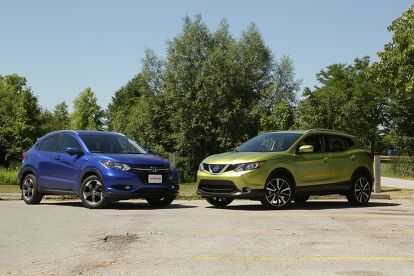




























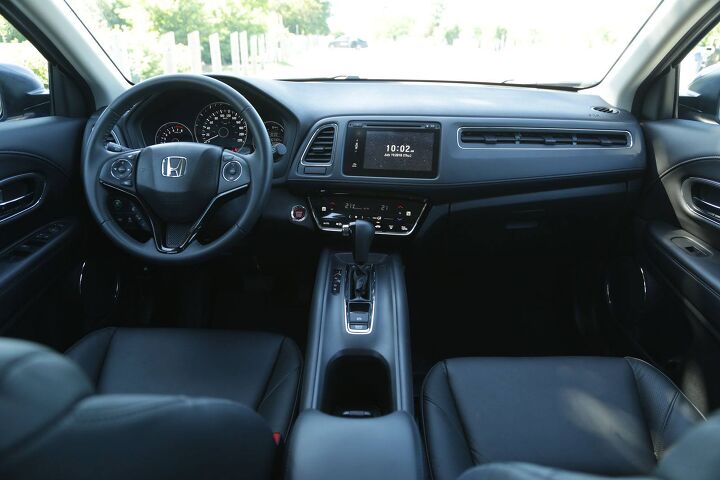















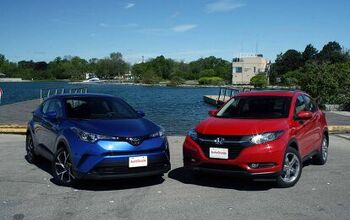
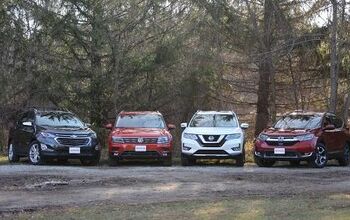

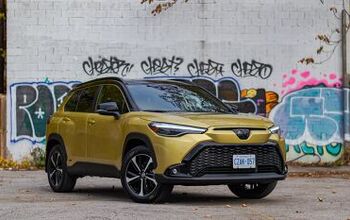




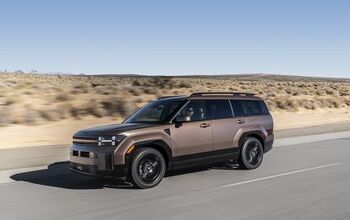

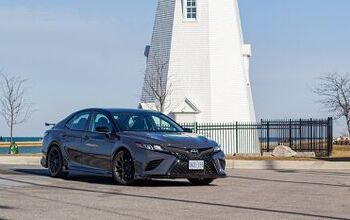
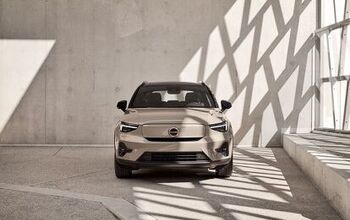



Comments
Join the conversation
I got news for you CG but the HRV was never the best to begin with.
I like the Rogue Sport much better.